#Fantastic Scherzo
Text
wild blue yonder is such a good fucking episode i love it when dw gets into weird cosmic horror
#fiona talks#like wby... midnight... SCHERZO... they're all so creepy and so effective#like i've got some mixed feelings about the specials overall but wby is just a fantastic fucking episode of tv everyone should watch it#dw#nuwho
6 notes
·
View notes
Text
YouTube Links: Tchaikovsky 4, Dvořák 9
Comments:
Tchaikovsky 4
Idk there's an explanation in my head but I jsut realy like how it soudns
I love the regal opening with the horns!! The second movement's sad and gentle theme starting in the oboe is just straight up edible... I think I've listened to the second movement of Tchaik 4 maybe more than any other movement of any symphony. MWAH! And then the third movement scherzo with pizzicato abound is SO FUN!!! And finally you round all of that off with a beautiful finale. My favorite Tchaikovsky symphony by far!!!
More propaganda for Tchaik 4: it's a representation of friendship. This piece was written in the worst year of his life, when he was married to his beard and it was torturing him, but his biggest solace during that time was his best friend Nadya. This was the first piece he truly dedicated to her (and she didn't usually allow dedications but she let him because she cared about him so much) and he also saw this piece as a sign of recovery. The fact that he dedicated this piece "to my best friend" really sells it tbh. It's so personal and intimate and playful and I love it.
Dvořák 9
I know it's gonna get nominated a hundred times, but I have listened to it four times in a row in the past week so I gotta mention it. Exquisite bliss from first to last note.
it slays <3
When I heard the first movement for the first time, I was GRINNING LIKE AN IDIOT because of how much I loved it. LIKE THIS IS SO YUMMY (link opens to the timestamp)
it's got everything. the interplay between minor and major. themes from the early movements that come back in the finale. the most iconic english horn solo in all of classical music. dvorak wrote it while traveling across the US and was directly inspired not only by his native czech/bohemian soundscapes but the musical languages he heard from black and native americans. there's a tuba part but it only plays for like five measures. fantastic orchestrations, making full use of all the different colors of the orchestra. the start of the finale sounds kinda like jaws. it is physically impossible for me to feel upset while i'm listening to it it's the first symphony i ever played in orchestra and i'm so normal about it that i want to get that EH solo tattooed on my art and also i wrote a paper about it for a university music history class and i got an A on it so it should definitely win the bracket or i'll cry
28 notes
·
View notes
Text
My thoughts on Wild Blue Yonder! A little late because the time between the 60th anniversary episodes almost exactly lined up with a visit from my girlfriend. We had a great time, and watched this episode together, but I didn't want to take enough time away from her to write this!
When I saw some EU fans joking about how the episode was going to be an adaptation of Scherzo, I wasn't prepared for how many similarities it had. And it was soooo good. I love some really fucking great Doctor Who. I loved the horror aspect, I loved the duologue aspect, I always love a mystery opening act where the Tardis team has to search for clues and theorise about where they've landed. Oh and a shape-shifter who takes on someone's whole identity and thoughts is a concept that always tickles my fancy.
One of the few nitpicks I have is that I'm not quite sure how the countdown/shifting corridors and the robot connect: if they're part of the same self-destruct system, why is the robot seemingly much older than the ship? If they're not part of the same system, why is there a countdown to the moment the robot presses the button? Why not just have the ship destroy itself, and why would the ship need to 'reconfigure itself to become a bomb' if it had a self-destruct? But (much like Heaven Sent, which the solitary shifting setting is reminiscent of,) the small logic hiccups don't really take anything away from how good the episode is.
A slightly larger nitpick is that the ending isn't the strongest, with the TARDIS coming back right when and where the Doctor was thinking that it should, and then the Doctor realising he picked the wrong Donna because of a miniscule detail (that the audience couldn't pick up on, so it feels a bit of a cheat and a cheap emotional shot). So some of RTD's most common flaws there, but again the negatives really don't stack up to much compared to the quality of the rest of it. Also, I didn't notice the Tardis screen at the end that showed a scan of Donna's arm until my rewatch, and, in classic me fashion, it put me in mind of a random Dr Who EU story. In this case, Project: Nirvana where the Doctor reveals that the Tardis automatically scanned someone coming onboard and flagged an eldritch-monster-shaped issue with her. It does make me wonder if the Doctor thought to scan Donna himself, or if the Tardis did it (and he took the credit, perhaps trying not to think about how he might never have noticed).
But that's enough with nitpicks, what are some other fantastic bits? The throwaway phrase "goosebumps like Braille" is rad as hell, and would've made a great episode title I think. I've had ideas before about the Doctor's compulsion to think and solve problems in front of him being a direct threat, so it was cool to see that idea here. The Doctor worrying about 'invoking a superstition at the edge of the universe' at the end was a vague but incredibly compelling hook for future plots, and infinitely more interesting than the Meep's final line from the previous episode. I love all the tiny subtle ways the not-things were off and unsettling, as well as all the ways that were so over-the-top that I was laughing through my shocked horror.
The Timeless Child and Flux references were fantastic peeling back of the Doctor's emotional walls, and it was nice tying in with what is technically the show's previous season, even though it came out 2 years ago now. Also... it's a little hard to mention those references without dunking on Chibnall in comparison, who didn't tap into the Doctor's emotional state anywhere near as intensely in several years as this episode did in one scene (You could tie this into the Doctor regenerates into what they need/opposite theories, with Thirteen being a relatively repressed Doctor and Ten Point Three being a relatively expressive Doctor). It was particularly nice to have the show actually establish what the consequences of the Flux actually were, because god knows Thirteen's episodes weren't interested in doing that. On my rewatch of series 13 a few months ago, I was amazed at how basically every element of the Flux is confused and contradictory, and at the end my brother and I were convinced that the Ood in the Division ship (or God Ood as we started calling him) must have reversed the very almost total destruction of the universe, because the show simply refused to acknowledge any of that destruction itself. I guess they split the difference and said half the universe. But unpicking the bizarre illogic of the Flux is a whole other post.
Keeping in mind that the next episode hasn't come out yet, Wild Blue Yonder feels wildly out of place in the middle of an anniversary trilogy. A trilogy where the bookends are RTD modern-day blockbusters filled with fan-favourite character returns and niche villains from the show's long history, and the middle is a limited-cast sci-fi psychological/eldritch horror. But that absurdity detracts from the episode in absolutely no way whatsoever.
And speaking of absurdity; the mounting hype and talk of big things happening in the next episode, on top of bringing back a long-forgotten old villain and a long-awaited new Doctor, is just making it more and more ridiculous that the episode is called The Giggle. I can't wait for it though, I'm really enjoying these specials.
#my thoughts#dw spoilers#donna#ten#suuuch a good episode#hard not to dunk on Chibnall when I say I'm enjoying TV Dr Who much more than I have in ages
17 notes
·
View notes
Note
hi! Since you like big finish I figured you might be the one to ask apologies if you don’t know you can just ignore this. But I’m wanting to get into the audios though they’re kinda pricey so I want to start at the right points. My fave characters are jenny flint and osgood (I know a strange combo) so I’m thinking UNIT and paternoster gang? Where’s best to start? Thanks
Hi! I am always happy to answer any and all Big Finish related questions! 😆😆😆
I have listened to both Paternoster Gang and UNIT audios and honestly, you can't go wrong, they're both a lot of fun!
Paternoster Gang is mostly just a good time, the stories are pretty straightforward, nothing overly complicated, but always enjoyable!
UNIT - The New Series is great! More ambitious than Paternoster Gang so personally, I prefer them, but that's just my personal preference of what I want out of a story. They're certainly grittier than the main show (particularly the latest series Nemesis) which I like and Kate and Osgood really get to shine. It's also nice to see them with some other recurring characters like River, the War Master or the Eleven throughout the run. It really is a very good series and there is a lot of it, which is great!
I completely understand the price point, I would highly recommend waiting for sales! Big finish do sales every week and the ones you're interested in are bound to come around every now and then. Feel free to dm me and I'll give you a shout when the sets come on sale, or just sign up to the newsletter 😉 I would never buy BF full price 😆😆
On that subject as well, you can get some of BF's Main Range audios for free on Spotify! These are for instance the Eighth's Doctor's adventures with Charley. While they can be a bit hit and miss, there are some brilliant episodes out there ("The Chimes or Midnight", "Neverland", "Zagreus", "Scherzo", "Natural History of Fear"...). So that could be a good first and free step into audio!
I would also not be doing my Big Finish stan duty if I didn't point out Doom Coalition to you. Any time I'm asked the question of where to start, that is my natural response! In my opinion it is the best set BF have ever done. It blends Classic and NuWho beautifully with the Eighth Doctor and River, two fantastic original companions, an outstanding original villain, top-notch acting all round and a plot that is so well thought out and executed, the main show should take note! Plus, the first episode you can get for free on the Big Finish website! 😉
So if I were you, I'd probably keep a look out for sales of the Paternoster Gang and UNIT audios and check out some of the free stuff in the meantime 😁😁
Hope that helps!
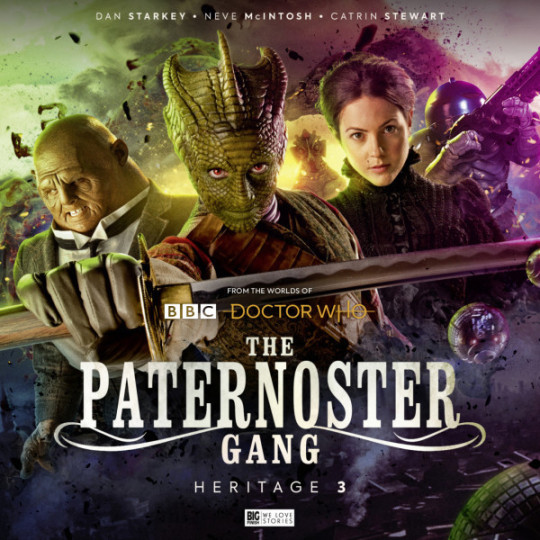


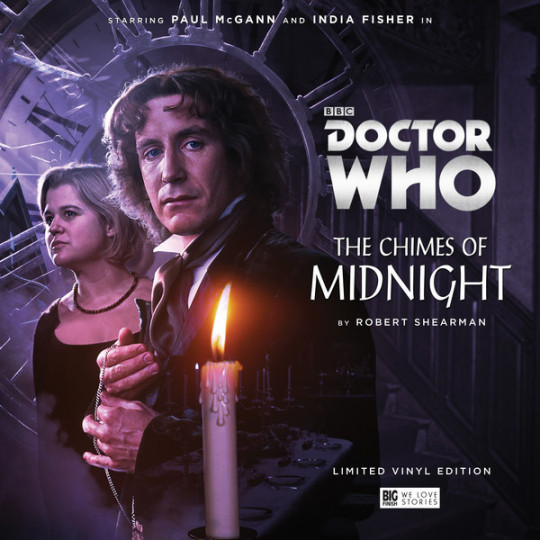

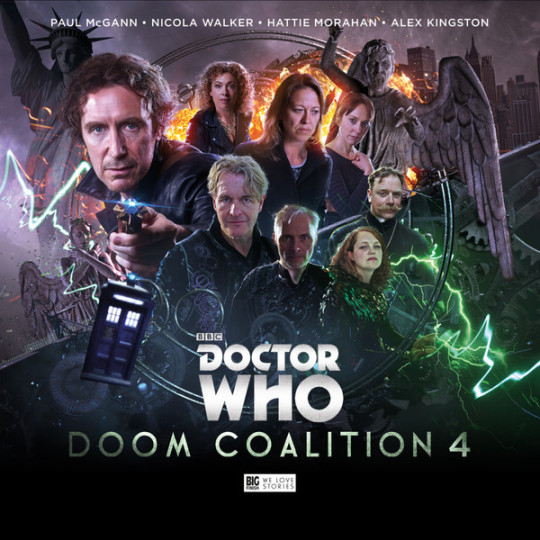
#doctor who#big finish#audios#paternoster gang#unit#kate stewart#osgood#madame vastra#jenny flint#strax#eighth doctor#river song#liv chenka#helen sinclair#doom coalition#the eleven#main range#charley pollard
35 notes
·
View notes
Text
Tumblr's Guide to Shostakovich: part 3- Artistic Beginnings, Ideological Formation, and the Conservatory Years
Hello and welcome back to Tumblr's Guide to Shostakovich, the weekly series where I discuss the life of Soviet composer Dmitri Dmitriyevich Shostakovich! In this installment, I'll be talking about events throughout Shostakovich's adolescence, including his family hardships, his time at the conservatory, and his First Symphony. The sources I'll be drawing from are Pauline Fairclough's Critical Lives: Dmitri Shostakovich, Elizabeth Wilson's Shostakovich: A Life Remembered, Laurel Fay's Shostakovich: A Life, and various articles of correspondence posted on the DSCH Publishers website, where I will also be sourcing much of my photographs.
At the age of thirteen, in 1919, Shostakovich left a general education at the School of Labour no. 108 to study music at the Petrograd Conservatory, directed by Aleksandr Glazunov, himself a famous composer in his own right (and friend of the late Pyotr Ilyich Tchaikovsky). Shostakovich studied composition under composer Maximillian Osseyevich Steinberg, and wrote his first numbered works, such as the Scherzo in F# Minor (Op. 1) and the Three Fantastic Dances (Op. 5). Shostakovich was an eager student who took inspiration from many contemporary composers of the time; while his early student works show traces of Tchaikovsky and even some Debussy, his later inspirations would include Bartok, Stravinsky, Hindemith, and Schoenberg, although he was also frequently influenced by Mussorgsky. His musical talents were noticed by his classmates and teachers, as this anecdote from Valerian Bogdanov-Berezovsky, his friend and classmate states:
"Shostakovich undoubtedly outstripped everyone in this art [music], as well as in aural dictation. One could already compare his hearing in its refinement and precision to a perfect acoustical mechanism (which he later was to develop still further), and his musical memory created the impression of an apparatus which made a photographic record of everything he heard."
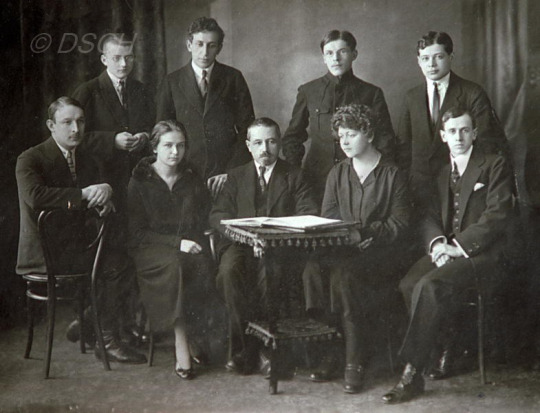
Shostakovich (top left) with Steinberg's (center) composition class, 1920s.
Hardship would rock the Shostakovich family when, in 1922, Dmitri Boleslavovich Shostakovich, the composer's father and main breadwinner of the family, died of pneumonia. Shostakovich would write his Suite for Two Pianos (Op. 6) in his father's memory, the first of many pieces he would write that would bear dedications to deceased loved ones. It was premiered by Shostakovich and his sister, Mariya.
After the death of her husband, Sofiya Vasiliyevna worked a variety of low-paying jobs, while her children also sought work to help support the family, with Mariya teaching piano lessons and Mitya finding work as a cinema pianist for silent film theaters. Shostakovich worked at three cinemas during this period- the Bright Reel, Splended Palace, and Piccadilly Theater. He resented cinema work; the pay was low, the managers dishonest, and his creative abilities stifled by both the insipid music he was required to play and the work taking time from his studies. (Reportedly, he was once thought to be drunk while attempting to imitate bird noises on the piano to accompany a film called Water Birds of Sweden. Amusingly, scholar Laurel Fay notes that "far from being stung by the criticism, Shostakovich expressed his pride in having distracted their attention from the film.") However, as much as Shostakovich hated cinema work, it provided him with stylistic inspiration, as shown in his Piano Trio no. 1 (Op. 8), as well as the opera and film scores he would write later on in his career.
While he worked tirelessly to support himself and his family, after the death of his father, a toll was being taken on Shostakovich's physical health. His godmother, Klavdia Lukashevich, noted that Shostakovich was given a "talented" ration" by the conservatory consisting of of "two spoons of sugar and half a pound of pork every fortnight," although this was not enough to sustain him. While Glazunov, reserving high hopes for his student, provided him with a stipend, a group of students had attempted to have it suspended. Likely due to malnutrition, in 1923, Shostakovich fell ill with tuberculosis and was sent to a sanatorium in the Crimea to recover. (He also met his first girlfriend and the dedicatee of Trio no. 1, Tatiana Glivenko, there, but the hot mess that relationship turned out to be deserves its own post.)
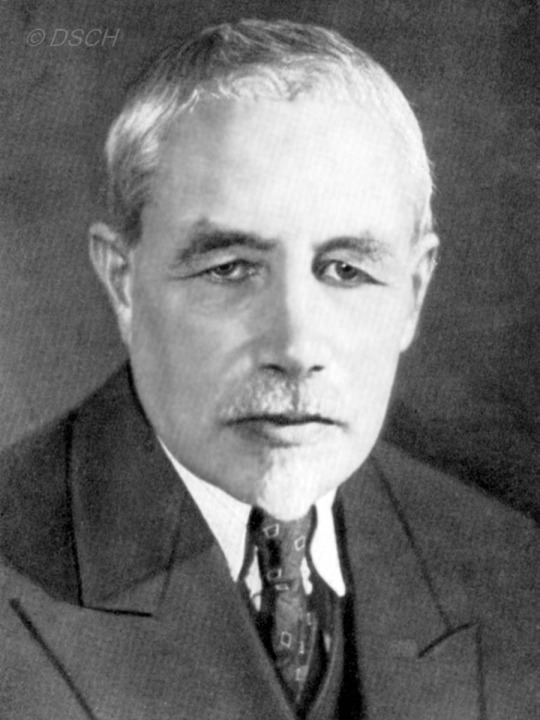
Maximillian Steinberg, Shostakovich's composition teacher.
In the wider political and social sphere, Shostakovich would gain both musical and ideological influences due to the advent of Lenin's New Economic Policy (NEP), a response to the failed economic policies of the Russian Civil War (1917-1923). The NEP, introduced in 1921 and later dissolved by Stalin in 1928, included a small capitalist sector to the economy, which was intended to be gradually phased out in a less aggressive approach to communism. While this period was far from utopian- censorship, corrupt business practices, and political unrest still abounded- the economic relief that the NEP provided led to a period of social progressivism that would later be reversed by the 1930s. During the NEP era, a wave of social reforms took place- in the sphere of sexuality and relationships, abortion and homosexuality were decriminalized, divorce was made easier (although this led to an increase in broken families, as men often readily divorced their wives after impregnating them), and "free love" movements took place. Meanwhile, in terms of social issues, the "Indigenization" movement sought to uplift the cultures of ethnic minorities in the Soviet Union (although it should be said this movement put Jews in a bizarre position; the banning of religion meant that while synagogues were desecrated and the Hebrew language banned, other aspects of Soviet Jewish culture, like Klezmer music, were promoted), and feminist ideals largely took hold, most notably spread by activists like Aleksandra Kollontai. And in the arts, the NEP resulted in a variety of works that blended avant-garde experimentation (also popular in the west at the time) with newly-forming Soviet ideals, such as Mayakovsky's play The Bedbug (which Shostakovich provided music for), Vsevolod Meyerhold's theatrical productions, and Aleksandr Mosolov's futurist musical compositions, most notably Iron Foundry. As Shostakovich worked with many artists of the NEP era and artistically "came of age" around this time, both social and artistic ideas would find a permanent place in his life and work, most notably the feminist themes of Lady Macbeth, his liberal attitudes towards sex and marriage (he himself would later enter an open marriage), and the avant-garde and oftentimes grotesque techniques he would employ in his music. A letter to his mother from his stay in the Crimea in 1923 highlights many of these views:
If, for instance, a wife stops loving her husband and gives herself to another man she has fallen in love with and in spite of social prejudice they start living together, there is nothing wrong about that. On the contrary, it’s even good that Love should be really free. Vows made in front of the altar [...] are the most terrible part of religion. Love cannot last for a long time. The best thing one could imagine is the complete abolition of marriage, namely of all the chains and duties that accompany love. This of course is a Utopia. If there is no marriage, there will be no family. That of course, would be very bad. One thing can be said for certain though - love is not free. Mamma dear, I must warn you that if I do fall in love one day I may well not try to tie myself down through marriage. Yet if I do marry and my wife falls in love with someone else, I shall not say pure word. If she wants a divorce, I shall give it to her and take the blame on myself. [...] Yet at the same time, there is the noble vocation of parenthood. When you start thinking about all this, your head is ready to explode. In any case, Love should be free!
In 1925, Shostakovich completed his First Symphony at the age of nineteen, as his graduation piece. It was premiered by his teacher, the conductor Nikolai Malko, who Shostakovich regarded as a "rather ungifted person" (his early letters show no small amount of arrogance!), but Malko nonetheless found the symphony impressive. It was premiered on May 12th, 1926, and received a largely positive reception that would cement Shostakovich as a promising composer, receiving praise from the likes of not only Soviet musicians, but prominent western ones such as Bruno Walter. While many accounts detail nothing but praise on the event of the symphony's premiere, Shostakovich held a much different opinion, detailing in lengthy letters to both his mother and his friend, Boleslav Yavorsky, the poor acoustics of the venue, blunders on behalf of the musicians, and even a nearby dog drowning out the music with a prolonged barking session. Despite how mortified he was at what he perceived to be the premiere's failure, Shostakovich would celebrate its anniversary for the rest of his life, later considering it his "second birth."
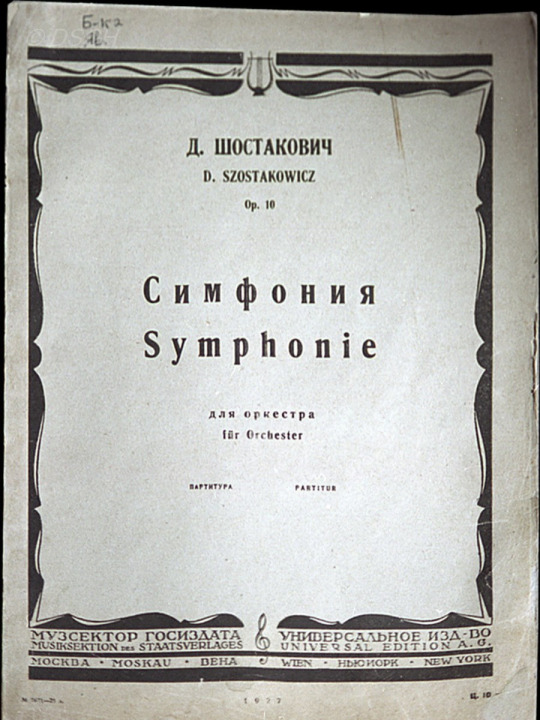
A first-edition score of Shostakovich's First Symphony. 1927.
Thank you for reading! In the next entries, I'll cover some events in Shostakovich's personal life and his operas The Nose and Lady Macbeth of the Mtsensk District- as well as the consequences that would follow.
#shostakovich#dmitri shostakovich#tumblr's guide to shostakovich#composer#classical music#music history#russian history#soviet history#music#classical music history
19 notes
·
View notes
Note
User natequarter, I felt it important to tell you that I have followed you due to your fantastic posts about the semi-obscure doctor who audio drama trilogy Neverland/Zagreus/Scherzo and for the fact you are an avid Humphrey bone enjoyer.
💥💥💥-lee
thank you! i do not post about zagreus so much now but damn if it isn't a fascinatingly fucked up audio
3 notes
·
View notes
Link
Check out this listing I just added to my Poshmark closet: Summer Tale Suk Fantastic scherzo CD New.
0 notes
Quote
Chopin – Piano Sonata no. 3 in B minor, op.58
You wouldn’t believe how disappointed I was when I realized I’d missed posting a work for one of my favorite composer’s birthdays. Yesterday might have been Fryderyk Chopin’s birthday, so I’ll be sharing yet another fantastic work by him. Now, a common “criticism” or observation of Chopin’s output is that he works best on smaller scales, in undesignated free form genre [that’s why his Preludes, Nocturnes, Waltzes, and Ballades are held in such high esteem]. Equal criticism has been shot at his piano sonatas, in a way to try and make them seem flawed. For example, the second sonata is famously seen as incoherent [I think it was Schumann who called it a family reunion among Chopin’s four most unruly children], but on closer inspection the work is tightly unified through the funeral march. Here, we have a more conventional sonata, a difficult work that harkens back to Beethoven, but with a heavy input of Chopin’s style [many Nocturne-like themes, chorals, and quasi-impressionist runs]. However, this work wasn’t performed in Chopin’s lifetime. But I think it is a highlight of the 19th century piano repertoire. My favorite moment in the work has to be the soft, nostalgic interlude in the third movement.
Movements:
1. Allegro maestoso
2. Scherzo: molto vivace
3. Largo
4. Finale: Presto non tanto
mikrokosmos: Chopin – Piano Sonata no. 3 in B minor, op.58 You wouldn’t believe how disappointed I was when I realized I’d missed posting a work for one of my favorite composer’s birthdays. Yesterday might have been Fryderyk Chopin’s birthday, so I’ll be sharing yet another fantastic work by him. Now, a common “criticism” or observation…
0 notes
Quote
Chopin – Piano Sonata no. 3 in B minor, op.58
You wouldn’t believe how disappointed I was when I realized I’d missed posting a work for one of my favorite composer’s birthdays. Yesterday might have been Fryderyk Chopin’s birthday, so I’ll be sharing yet another fantastic work by him. Now, a common “criticism” or observation of Chopin’s output is that he works best on smaller scales, in undesignated free form genre [that’s why his Preludes, Nocturnes, Waltzes, and Ballades are held in such high esteem]. Equal criticism has been shot at his piano sonatas, in a way to try and make them seem flawed. For example, the second sonata is famously seen as incoherent [I think it was Schumann who called it a family reunion among Chopin’s four most unruly children], but on closer inspection the work is tightly unified through the funeral march. Here, we have a more conventional sonata, a difficult work that harkens back to Beethoven, but with a heavy input of Chopin’s style [many Nocturne-like themes, chorals, and quasi-impressionist runs]. However, this work wasn’t performed in Chopin’s lifetime. But I think it is a highlight of the 19th century piano repertoire. My favorite moment in the work has to be the soft, nostalgic interlude in the third movement.
Movements:
1. Allegro maestoso
2. Scherzo: molto vivace
3. Largo
4. Finale: Presto non tanto
mikrokosmos: Chopin – Piano Sonata no. 3 in B minor, op.58 You wouldn’t believe how disappointed I was when I realized I’d missed posting a work for one of my favorite composer’s birthdays. Yesterday might have been Fryderyk Chopin’s birthday, so I’ll be sharing yet another fantastic work by him. Now, a common “criticism” or observation…
0 notes
Quote
Chopin – Piano Sonata no. 3 in B minor, op.58
You wouldn’t believe how disappointed I was when I realized I’d missed posting a work for one of my favorite composer’s birthdays. Yesterday might have been Fryderyk Chopin’s birthday, so I’ll be sharing yet another fantastic work by him. Now, a common “criticism” or observation of Chopin’s output is that he works best on smaller scales, in undesignated free form genre [that’s why his Preludes, Nocturnes, Waltzes, and Ballades are held in such high esteem]. Equal criticism has been shot at his piano sonatas, in a way to try and make them seem flawed. For example, the second sonata is famously seen as incoherent [I think it was Schumann who called it a family reunion among Chopin’s four most unruly children], but on closer inspection the work is tightly unified through the funeral march. Here, we have a more conventional sonata, a difficult work that harkens back to Beethoven, but with a heavy input of Chopin’s style [many Nocturne-like themes, chorals, and quasi-impressionist runs]. However, this work wasn’t performed in Chopin’s lifetime. But I think it is a highlight of the 19th century piano repertoire. My favorite moment in the work has to be the soft, nostalgic interlude in the third movement.
Movements:
1. Allegro maestoso
2. Scherzo: molto vivace
3. Largo
4. Finale: Presto non tanto
mikrokosmos: Chopin – Piano Sonata no. 3 in B minor, op.58 You wouldn’t believe how disappointed I was when I realized I’d missed posting a work for one of my favorite composer’s birthdays. Yesterday might have been Fryderyk Chopin’s birthday, so I’ll be sharing yet another fantastic work by him. Now, a common “criticism” or observation…
0 notes
Quote
Chopin – Piano Sonata no. 3 in B minor, op.58
You wouldn’t believe how disappointed I was when I realized I’d missed posting a work for one of my favorite composer’s birthdays. Yesterday might have been Fryderyk Chopin’s birthday, so I’ll be sharing yet another fantastic work by him. Now, a common “criticism” or observation of Chopin’s output is that he works best on smaller scales, in undesignated free form genre [that’s why his Preludes, Nocturnes, Waltzes, and Ballades are held in such high esteem]. Equal criticism has been shot at his piano sonatas, in a way to try and make them seem flawed. For example, the second sonata is famously seen as incoherent [I think it was Schumann who called it a family reunion among Chopin’s four most unruly children], but on closer inspection the work is tightly unified through the funeral march. Here, we have a more conventional sonata, a difficult work that harkens back to Beethoven, but with a heavy input of Chopin’s style [many Nocturne-like themes, chorals, and quasi-impressionist runs]. However, this work wasn’t performed in Chopin’s lifetime. But I think it is a highlight of the 19th century piano repertoire. My favorite moment in the work has to be the soft, nostalgic interlude in the third movement.
Movements:
1. Allegro maestoso
2. Scherzo: molto vivace
3. Largo
4. Finale: Presto non tanto
mikrokosmos: Chopin – Piano Sonata no. 3 in B minor, op.58 You wouldn’t believe how disappointed I was when I realized I’d missed posting a work for one of my favorite composer’s birthdays. Yesterday might have been Fryderyk Chopin’s birthday, so I’ll be sharing yet another fantastic work by him. Now, a common “criticism” or observation…
0 notes
Video
youtube
Josef Suk (1874-1935) : Fantastic Scherzo, Op.35 ·
Czech Philharmonic Orchestra · Sir Charles Mackerras
1 note
·
View note
Photo

Quando mi dice: ‘’Tranquilla è solo un’amica’’
15 notes
·
View notes
Text
this piece was stuck in my head earlier so i thought i'd share!
it's actually not a very well-known piece from what i can tell. it's Josef Suk's Fantastic Scherzo. These 'fantastical' scherzos became popular at one point in the late romantic era, with pieces such as the sorcerer's apprentice. this is one such piece!
youtube
fun fact- the first time i ever heard this piece was performed live. the cello part that sounds all waltz-like is amazing in a live setting. they played sibelius's violin concerto afterwards it was amazing.
anyway i hope y'all find it as enjoyable as i do :)
7 notes
·
View notes
Text
Oct 14 (Stage 3)
Evening Session
Kyohei Sorita
Mazurka in B major Op. 56 no 1
Mazurka in C major Op. 56 no 2
Mazurka in C minor Op. 56 no 3
Sonata in B flat minor Op. 35
Boże, coś Polskę (harmonization of the old version of the song for piano), op. posth.
Polonaise in A flat major, Op. 53
Mazurkas were raw, very folk-sy. Sonata: Marche funèbre---tremendous emotions! Fantastic middle part. Great polonaise, with fantastic changes of dynamics and interesting tempo, very electrifying. I need to check out the old version of "Boże, coś Polskę" (Oh, Lord, you've watched over Poland for hundreds of years), because it sounded very interesting.
Rec: Marche funèbre from sonata & Polonaise
Hayato Sumino
Mazurka in G minor Op. 24 no 1
Mazurka in C major Op. 24 no 2
Mazurka in A flat major Op. 24 no 3
Mazurka in B flat minor Op. 24 no 4
Polonaise-Fantasy in A flat major op. 61
Sonata in B flat minor Op. 35
Scherzo in C sharp minor Op. 39
He used the pedal in a very interesting way. Polonaise-Fantasy: a few days ago radio speakers were talking about how it's important to see the polonaise in the left hand and I think he managed it, at least partially.
Rec: Polonaise-Fantasy
Andrzej Wierciński
Mazurka in G minor Op. 24 no 1
Mazurka in C major Op. 24 no 2
Mazurka in A flat major Op. 24 no 3
Mazurka in B flat minor Op. 24 no 4
Scherzo in E flat major, Op. 54
Sonata in B minor, Op. 58
Scherzo: I can't name them, but there were definitely some strong emotions. He definitely had a history to share with this piece. Sonata: he almost convinced me to change my mind, especially by the more lyrical parts.
Rec: Scherzo
Piotr Alexewicz
Mazurka in G minor Op. 24 no 1
Mazurka in C major Op. 24 no 2
Mazurka in A flat major Op. 24 no 3
Mazurka in B flat minor Op. 24 no 4
Preludes Op. 28:
No. 1 in C major
No. 2 in A minor
No. 3 in G major
No. 4 in E minor
No. 5 in D major
No. 6 in B minor
No. 7 in A major
No. 8 in F sharp minor
No. 9 in E major
No. 10 in C sharp minor
No. 11 in B major
No. 12 in G sharp minor
No. 13 in F sharp major
No. 14 in E flat minor
No. 15 in D flat major
No. 16 in B flat minor
No. 17 in A flat major
No. 18 in F minor
No. 19 in E flat major
No. 20 in C minor
No. 21 in B flat major
No. 22 in G minor
No. 23 in F major
No. 24 in D minor
Rec: Preludes Nos. 2, 4, 11, 13, 14, 15, 20, 21, 23
4 notes
·
View notes
Note
Well since I'm inexplicably awake at this time: 19, 26 and 33 for the Star Wars ask please :3
Greetings, my dragon squire!
You asked for it:
19. What is your favorite musical theme?
I HAVE A LOT this is hard.
If we’re going with classic John Williams, I can’t deny that “Across the Stars” is the greatest love theme ever written despite my feelings about Anakin and Padme’s relationship. Also a huge fan of “Scherzo for X-Wings” from TFA.
I also love so many non-John Williams themes: Kevin Kiner’s “Where The Sun Sails And The Moon Walks” from Rebels and “Burying The Dead” from Clone Wars both never fail to make me cry.
“Rebellions Are Built On Hope” from Rogue One is fantastic, as well as…Samuel Kim’s final trailer music for TROS is just. so fucking great. I listen to that all the time and get emotional.
26. Which planet would you live on?
Endor with the murder teddy bears would be great…who doesn’t love giant trees and tiny ewoks.
Scarif seemed like a nice destination, sans Imperial occupation but uhhhh, didn’t end too nicely there.
33. What would your weapon be/look like?
As someone who’s not a fan of lightsabers OR guns I would be down with a vibro-ax or bo-rifle!
ask me questions about star wars!
2 notes
·
View notes